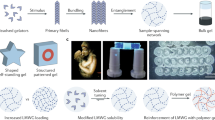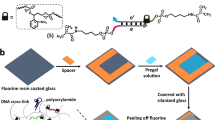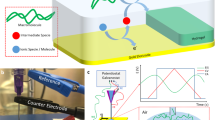Abstract
The polymer gels called hydrogels may be induced to swell or shrink (taking up or expelling water between the crosslinked polymer chains) in response to a variety of environmental stimuli, such as changes in pH or temperature, or the presence of a specific chemical substrate1. These gels are being explored for several technological applications, particularly as biomedical materials2. When hydrogels swell or shrink, complex patterns may be generated on their surfaces3,4,5,6,7. Here we report the synthesis and controlled modulation of engineered surface patterns on environmentally responsive hydrogels. We modify the character of a gel surface by selectively depositing another material using a mask. For example, we use sputter deposition to imprint the surface of an N-isopropylacrylamide (NIPA) gel with a square array of gold thin films. The periodicity of the array can be continuously varied as a function of temperature or electric field (which alter the gel's volume), and so such an array might serve as an optical grating for sensor applications. We also deposit small areas of an NIPA gel onthe surface of an acrylamide gel; the patterned area can be rendered invisible reversibly by switching the temperature above or below the lower critical solution temperature of the NIPA gel. We anticipate that these surface patterning techniques may find applications in display and sensor technology.
This is a preview of subscription content, access via your institution
Access options
Subscribe to this journal
Receive 51 print issues and online access
$199.00 per year
only $3.90 per issue
Buy this article
- Purchase on Springer Link
- Instant access to full article PDF
Prices may be subject to local taxes which are calculated during checkout




Similar content being viewed by others
References
Tanaka, T. Gels. Sci. Am. 244, 124–138 (1981).
Peppas, N. A. & Langer, R. New challenges in biomaterials. Science 263, 1715–1720 (1994).
Tanaka, T.et al. Mechanical instability of gels at the phase transition. Nature 325, 796–798 (1987).
Sato-Matsuo, E. & Tanaka, T. Patterns in shrinking gels. Nature 358, 482–485 (1992).
Li, Y., Li, C. & Hu, Z. Pattern formation of constrained acrylamide/sodium acrylate copolymer gels in acetone/water mixture. J. Chem. Phys. 100, 4637–4644 (1994).
Li, C., Hu, Z. & Li, Y. Temperature and time dependence of patterns of surface patterns in constrained ionic N-isopropylacrylamide gels. J. Chem. Phys. 100, 4645–4652 (1994).
Suzuki, A., Yamazaki, M. & Kobiki, Y. Direct observation of polymer gel surfaces by atomic force microscopy. J. Chem. Phys. 104, 1751–1757 (1996).
Grabar, K. C., Freeman, G. G., Hommer, M. B. & Natan, M. J. Preparation and characterization of Au colloid monolayers. Anal. Chem. 67, 735–743 (1995).
Hirotsu, S. Electric-field-induced phase transition in polymer gels. Jpn J. Appl. Phys. 24, 396–398 (1985).
Weissman, J. M., Sunkara, H. B., Tse, A. S. & Asher, S. A. Thermally switchable periodicities and diffraction from mesoscopically ordered materials. Science 274, 959–960 (1996).
Imisides, M. D., John, R. & Wallace, G. G. Microsensors based on conducting polymers. Chemtech 26, 19–25 (1996).
Wang, J. & Chen, Q. Enzyme microelectrode array strips for glucose and lactate. Anal. Chem. 66, 1007–1011 (1994).
Misch, W., Bock, J., Egert, U., Hammerle, H. & Mohr, A. Athin film microelectrode array for monitoring extracellular neuronal activity in vitro. Biosensors Bioelectr. 9, 737–741 (1994).
Hu, Z., Zhang, X. & Li, Y. Synthesis and application of modulated polymer gels. Science 269, 525–527 (1995).
Li, Y., Wang, G. & Hu, Z. Turbidity study of spinodal decomposition of N-isopropylacrylamide gels. Macromolecules 28, 4194–4197 (1995).
Bansil, R., Liao, G. & Falus, P. Kinetics of spinodal decomposition in chemically crosslinked gels. Physica A 231, 346–358 (1996).
Acknowledgements
We thank the Donors of the Petroleum Research Fund, administered by the American Chemical Society, and the US Army Research Office for support of this work.
Author information
Authors and Affiliations
Rights and permissions
About this article
Cite this article
Hu, Z., Chen, Y., Wang, C. et al. Polymer gels with engineered environmentally responsive surface patterns. Nature 393, 149–152 (1998). https://doi.org/10.1038/30205
Received:
Accepted:
Issue Date:
DOI: https://doi.org/10.1038/30205
This article is cited by
-
Tardigrade-inspired extremotolerant glycerogels
NPG Asia Materials (2023)
-
Thermo-responsive release of rhodamine B in the pore-selective poly(N-isopropylacrylamide) immobilized honeycomb-patterned porous film
Polymer Bulletin (2022)
-
Mechanically tunable single-component soft polydimethylsiloxane (PDMS)-based robust and sticky superhydrophobic surfaces
Applied Physics A (2019)
-
Improvement of toughness for the hyaluronic acid and adipic acid dihydrazide hydrogel by PEG
Fibers and Polymers (2017)
-
Temperature/pH dual responsive OPGMA based copolymeric hydrogels prepared by gamma radiation: an optimisation study
Journal of Polymer Research (2016)
Comments
By submitting a comment you agree to abide by our Terms and Community Guidelines. If you find something abusive or that does not comply with our terms or guidelines please flag it as inappropriate.



